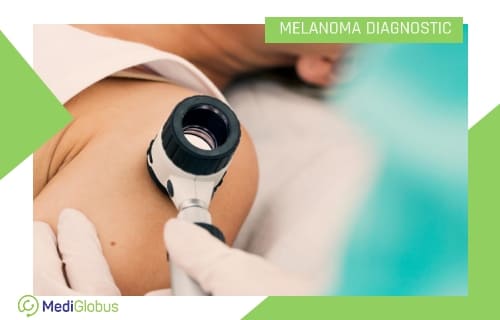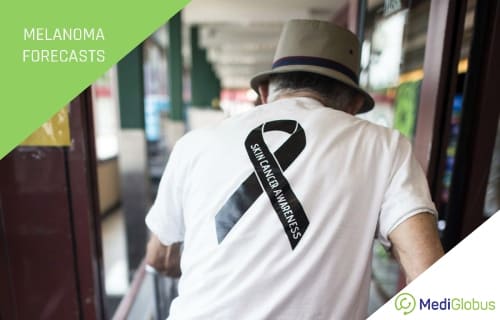The incidence of melanoma is steadily increasing globally. Over the past 40 years, the number of cases has increased by 800% among young women and 400% among young men. This is the most rapidly progressing type of cancer. However, despite the high mortality rate, early diagnosis of melanoma gives a good chance of recovery. The discovery of targeted therapy, as well as immunotherapy made melanoma a disease after which a person can live a longer life, but all this is possible if it is detected early and followed up with modern treatment. Let’s consider what diagnosis and methods of therapy should be used in order to provide the greatest chances for recovery.
DIAGNOSIS OF MELANOMA
The first thing that the patient should do who has a suspicion of malignant skin formation is the examination from a specialist. Before proceeding to the study of the mole, the doctor will certainly specify the presence of risk factors.
First is to know the cases of oncological diseases in family;
Secondly, the number of serious sunburns received during the lifetime (it is believed that if there were more than 5, the risk of melanoma is increased by 80%);
Also important factor is whether you used the solarium and how often (after all, 15 minutes in a solarium are equivalent to a whole day under the direct influence of ultraviolet rays on the beach);
Thirdly, the doctor will certainly check the number of moles, if more than 50, the risk of skin cancer is increased. And, of course, the general symptoms of malaise can indicate a disease;
Next step is to perform the dermatoscopy procedure with the examination of lymph nodes. To study moles, a modern dermatoscope is used, which shines through the moles and makes it possible to see changes in their structure;
Further, the doctor examines the lymph nodes, the increase of which is also a sign of the pathological process;

If a melanoma is suspected, a biopsy is performed. For this, a sample of the mole is taken and sent to the laboratory for examination. Depending on the type of biopsy (shaving, puncture, excision), the upper layer of the mole, the surface and deep layers, or the mole is completely removed, respectively.
The gold standard is the last type of biopsy, which is called excision. Thanks to this diagnostic procedure, the doctor’s assumptions are confirmed or disproved. In addition to the very presence of melanoma, a biopsy provides information on the degree of tumor germination in the skin (Tumor from 0 to 4).
If the melanoma has grown sufficiently deep and reached the dermis layer, a biopsy of the guard nodes is performed to detect metastases. With a thickness of melanoma 1-2 mm, metastases in the “guard” lymph nodes are revealed in 12-19.7% of cases, with a thickness of 2-4 mm – in 28-33.2%, and with a thickness of more than 4 mm – in 28-44 %. The risk of metastasis depends not only on the thickness of the tumor and the degree of its germination, but also on the age of the patient. Interestingly, the incidence of metastases in the regional lymph nodes decreases with age.
To carry out a biopsy of watchdogs, a colorant is introduced next to the tumor. With the help of visual methods of diagnosis, a lymph node is identified and its tissue is excised. On whether metastases will be diagnosed in it, subsequent diagnostics and therapy depend.
If there are metastases, it is necessary to determine the process of their spread. For this purpose, the body is diagnosed with MRI, CT, PET-CT (depending on which organ the symptoms indicate). Also to monitor the treatment process, namely the quality of excision of the tumor, the presence of metastases, the risk of recurrence, a blood test for oncomarkers is performed.
| Oncological check-up |
|---|
| Blood tests for cancer markers |
| Biopsy |
| CT/MRI/PET-CT |
| Consultation with an oncologist |
IS MELANOMA TREATABLE?
Yes, today there are innovative therapies that demonstrate high effectiveness. These are targeted therapy and immunotherapy, which complement the traditional procedure of tumor excision, chemotherapy and radiotherapy. But first things first.
Tumor excision is the method from which melanoma treatment begins. Doctors remove a dangerous mole/nevus, grabbing a small area around. If the formation is large, a skin transplant procedure is necessary.
These drugs include Ipilimumab (blocks the protein CTLA-4 and stimulates the immune response against melanoma), as well as Keytruda (blocks the protein PD-1, which strengthens the antitumor response of the immune system).

Target therapy
Involves the use of special drugs that are aimed at the cancer cells. In the case of melanoma, these are the so-called inhibitors of the BRAF gene: vemurafenib, dabrafenib, trametinib and others. Due to the use of these drugs, the size of the tumor is reduced and the overall condition of the patient is improved.
Immunotherapy
Stimulation of one’s own immune system for recognition of cancer cells and fight against cancer. A new generation of immunotherapy drugs are monoclonal antibodies (directed against one determinant of a particular complex antigen).
FORECASTS OF SURVIVAL WITH MELANOMA

In addition to melanoma, the survival rate also depends on the race and age of the patient. If representatives of the white race have an average survival rate for early diagnosis of 93%, then for African Americans, this percentage is much lower – 69%. Also less likely to be cured are patients aged, compared to young people. When diagnosing melanoma in stages I-A and I-B (the size of a mole to 1 mm), the five-year survival rate in 97% and 92%, respectively. In the stages II-A and I-B – 81% and 70%.
At the stage II-C (without metastases), the survival prognosis may even be lower (53%) than in the ІІІ-A stage (with metastases) if the tumor has a size larger than 4 mm. In stages III-B and III-C, the percentage of five-year survival is reduced to 59% and 40%, respectively. At the last stage, only 15-20% of patients survive for five years, and the 10-year survival rate drops to 10%.
For detailed information on the diagnosis and treatment of melanoma, leave a request on the site. Our Doctor coordinator will answer all your queries .





